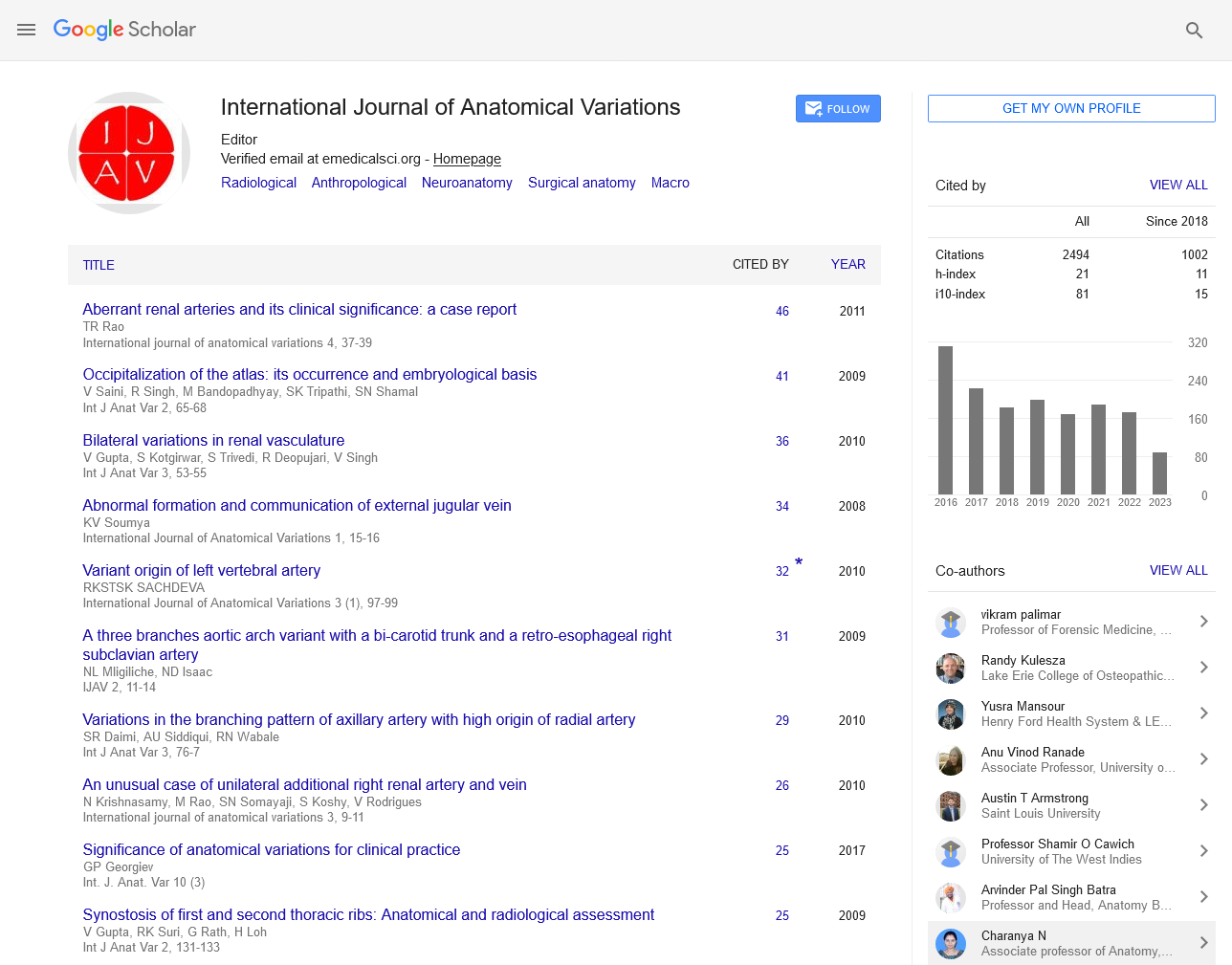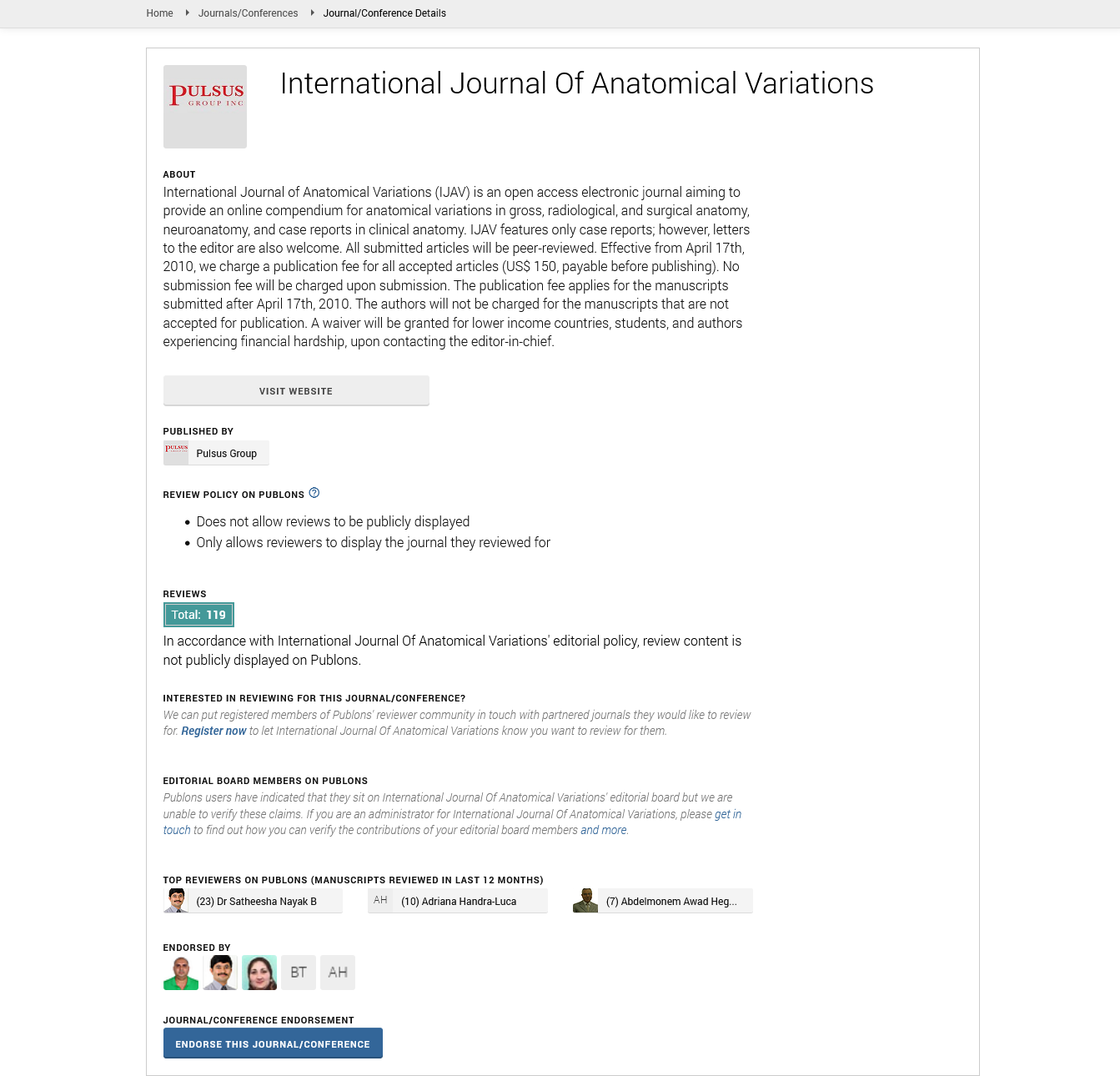Anatomical Anomalies A Comprehensive Review of Etiology Classification Diagnosis and Clinical Implications
Received: 01-Feb-2025, Manuscript No. ijav-25-7623; Editor assigned: 04-Feb-2025, Pre QC No. ijav-25-7623 (PQ); Reviewed: 19-Feb-2025 QC No. ijav-25-7623; Revised: 26-Feb-2025, Manuscript No. ijav-25-7623 (R); Published: 28-Feb-2025, DOI: 10.37532/1308-4038.18(2).487
Citation: Nayak S. Anatomical Anomalies a Comprehensive Review of Etiology Classification Diagnosis and Clinical Implications. Int J Anat Var. 2025;18(2): 741-742.
This open-access article is distributed under the terms of the Creative Commons Attribution Non-Commercial License (CC BY-NC) (http://creativecommons.org/licenses/by-nc/4.0/), which permits reuse, distribution and reproduction of the article, provided that the original work is properly cited and the reuse is restricted to noncommercial purposes. For commercial reuse, contact reprints@pulsus.com
Abstract
Anatomical anomalies are deviations from the typical structure or location of body parts that can have a wide range of clinical, functional, and developmental implications. These anomalies may be congenital or acquired, symptomatic or asymptomatic, and can involve virtually any system in the human body. This paper provides a comprehensive overview of anatomical anomalies by exploring their etiology, classification, methods of diagnosis, and implications for clinical practice. It draws from existing literature in anatomy, radiology, genetics, and clinical medicine to present a cohesive understanding of this important yet often underappreciated area of human biology.
INTRODUCTION
Anatomical anomalies are structural deviations that differ from the norm in terms of morphology, location, number, or development of body parts. They may arise during embryogenesis or develop due to injury, disease, or environmental influences later in life. While some anomalies are incidental findings, others have significant pathological consequences [1]. With the increased use of advanced imaging technologies and prenatal diagnostics, the identification and characterization of these anomalies have become more precise, leading to enhanced management strategies. Anatomical anomalies—structural deviations from typical anatomical patterns—represent a diverse group of conditions that can significantly impact human health and clinical outcomes. These anomalies may arise during embryological development due to genetic, environmental, or multifactorial influences [2], and their manifestations range from minor variations to complex malformations involving multiple organ systems. Understanding the etiology and classification of anatomical anomalies is essential for accurate diagnosis and effective clinical management. This comprehensive review aims to provide an in-depth analysis of the origins and types of anatomical anomalies, exploring the mechanisms that underlie their development. We also examine current diagnostic strategies, including imaging and genetic testing, and highlight their role in early detection and treatment planning. Finally, we consider the broader clinical implications of anatomical anomalies, from surgical considerations to long-term patient care, emphasizing the need for a multidisciplinary approach in addressing these conditions [3].
ETIOLOGY OF ANATOMICAL ANOMALIES
Genetic mutations, chromosomal abnormalities, and inherited syndromes often underlie congenital anatomical anomalies. Conditions such as Down syndrome, Turner syndrome, and Marfan syndrome are associated with specific structural deviations, including cardiac malformations, skeletal deformities, and organ displacement [4].
ENVIRONMENTAL AND TERATOGENIC FACTORS
Exposure to certain drugs, toxins, radiation, or infectious agents during critical periods of fetal development can result in anatomical anomalies. Teratogenic substances like thalidomide or maternal infections such as rubella have historically contributed to severe birth defects [5].
MECHANICAL AND VASCULAR DISRUPTIONS
Mechanical forces, such as amniotic bands or uterine constraints, can distort normal growth patterns. Similarly, vascular disruptions may impair the blood supply to developing tissues, leading to anomalies such as limb deficiencies or intestinal atresias.
CLINICAL EVALUATION
Physical examination, family history, and symptom assessment remain crucial. Multidisciplinary assessments often yield the most comprehensive understanding.
CLINICAL IMPLICATIONS
Unexpected anatomical variants can complicate surgical procedures. Preoperative imaging and careful planning are essential to avoid intraoperative surprises. While some anomalies are asymptomatic, others can cause pain, functional impairment, or life-threatening complications. For example, vascular ring anomalies may cause respiratory distress in infants. Patients with visible anomalies or functional disabilities often face psychological and social challenges. Early counseling, rehabilitation, and support can improve quality of life.
FUTURE DIRECTIONS AND RESEARCH
Emerging fields such as regenerative medicine, 3D printing, and gene editing (e.g., CRISPR) offer promising avenues for correcting or compensating for certain anatomical anomalies. Further research into gene-environment interactions could elucidate more precise prevention strategies.
CONCLUSION
Anatomical anomalies encompass a broad spectrum of structural deviations that can significantly impact health outcomes. Understanding their origins, classifications, and clinical relevance is vital for accurate diagnosis and effective treatment. With advances in diagnostic technology and therapeutic options, healthcare providers are better equipped than ever to manage these anomalies proactively and compassionately.
REFERENCES
- Constable DP, Hinchcliff WK, Done SH, Grunberg W (2017) Veterinary Medicine A Textbook of the Diseases of Cattle, Horses, Sheep, Pigs, and Goats. 11th ed. Elsevier Missouri USA 1228-1238.
- Abebe A (2012) Major challenges and gaps in rabies prevention and control. In Proceedings of the national workshop on rabies prevention and control in Ethiopia. 18-19.
- Aga AM, Hurisa B, Urga K (2016) Current situation of rabies prevention and control in developing countries: Ethiopia perspective. Infectious Prev Med Infect Dis 4: 1-6.
- Cleveland S, Kaare M, Tiringa P, Mlengeya T, Barrat J (2003) A dog rabies vaccination campaign in rural Africa: impact on the incidence of dog rabies and human dog-bite injuries. Vaccine 21: 1965-1973.
- Collier L, Oxford J (2006) Human Virology. 3rd ed. Oxford University Press Inc New York, USA. 189-194.
Indexed at, Google Scholar, Crossref
Indexed at, Google Scholar, Crossref






